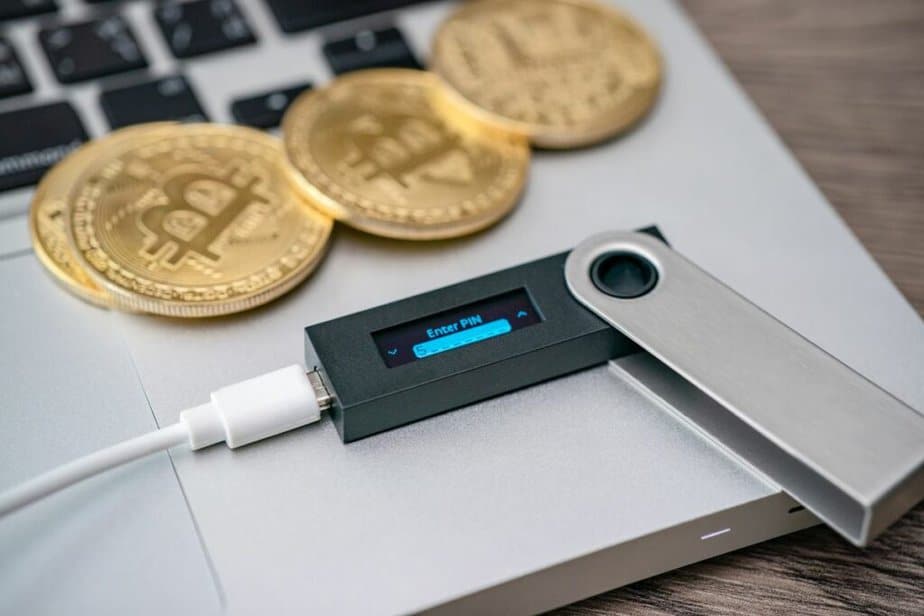What Are Web3 Wallets? 13 Things You Should Know!
We’re reader-supported; we may earn a commission from links in this article.
In today’s digital age, cryptocurrency is slowly becoming the norm for online transactions, and it is not just limited to Bitcoin anymore.
With the emergence of blockchain technology, the entire digital financial ecosystem is evolving rapidly, leading to innovations such as Web3 wallets.
In this article, we’ll explore what Web3 wallets are, how they work, and why they are gaining popularity.
Read on to find out more!

1. What is web3 technology?
Before diving into web3 wallets, it’s important to understand the technology behind them.
Web3 technology is a collection of protocols and technologies that enable decentralized applications to operate on a blockchain network.
Unlike traditional Web2 applications, which rely on centralized servers, Web3 applications are decentralized, meaning they operate on a distributed network of computers.
2. What are web3 wallets?

Web3 wallets, also known as crypto wallets, are designed to operate on the web3 stack, a collection of protocols and technologies that enable decentralized applications (dApps) to operate on a blockchain network.
Web3 wallets are unique because they give users more control over their digital assets than traditional wallets, which are typically centralized and managed by a third party.
Web3 wallets are unique because they give users more control over their digital assets than traditional wallets, which are typically centralized and managed by a third party.
Cryptocurrency is becoming increasingly popular, and as more people adopt it, the need for secure storage and management of digital assets becomes more important.
3. How do web3 wallets work?
Web3 wallets work by generating public and private key pairs, which are used to the wallet address, sign transactions, and interact with dApps.
The public key acts as the wallet’s address, while the private key is used to sign transactions and authorize access to the wallet.
When a user interacts with a Web3-enabled dApp, the dApp generates a transaction request, which is then signed by the user’s Web3 wallet using the private key.
The signed transaction is then broadcast to the blockchain network, which validates and executes the transaction.
4. What are the advantages of web3 wallets?
Web3 wallets offer several advantages over traditional wallets.
One of the most significant advantages is their decentralized nature, meaning users have complete control over their digital assets.
Web3 wallets also offer enhanced security, using advanced encryption techniques to protect users’ private keys.
In addition to security, web3 wallets offer improved interoperability, meaning they can interact with different blockchain networks and protocols.
This makes it easier for users to manage their software wallets and transfer their digital assets between networks without switching between wallets.
5. Key Features of Web3 Wallets

Some of the key features of web3 wallets include:
a. Decentralized
Web3 wallets are built on decentralized infrastructure, making them more secure and resilient to hacking and data breaches.
b. Interoperable
Web3 wallets can interact with different blockchain networks, enabling users to manage and transact multiple cryptocurrencies seamlessly.
c. Self-Sovereign
Web3 wallets give users complete control over their digital assets and identities, eliminating the need for intermediaries.
d. User-Centric
Web3 wallets are designed with the user in mind, providing a seamless and user-friendly experience.
6. Advantages of Web3 Wallets
Web3 wallets offer several advantages over traditional paper wallets. As mentioned earlier, they offer enhanced security and improved interoperability.
They also give users more control over their digital assets, as they are decentralized and not managed by a third party.
This means that users have complete control over their private keys and can easily manage their digital assets.
7. The Difference Between Web2 and Web3 Wallets
Web2 wallets are traditional digital wallets that store and manage cryptocurrencies on centralized platforms.
They rely on centralized servers to process transactions and store user data.
On the other hand, Web3 wallets are designed to interact with decentralized applications, enabling users to receive digital assets and interact with dApps seamlessly without relying on centralized servers.
Web3 wallets are built on decentralized infrastructure, making them more secure and resilient to hacking and data breaches. They are more user-centric and decentralized finance, providing users with complete control over their digital assets and identities.
8. Types of Web3 Wallets
There are different types of web3 wallets available in the market, each with its unique features and functionalities.
Some of the common types of web3 wallets include:
a. Browser Extension Wallets
These wallets are browser extensions that integrate with your web browser, enabling you to interact with dApps seamlessly.
b. Mobile Wallets
These wallets are mobile applications that allow you to manage your cryptocurrencies on the go.
c. Hardware Wallets
These wallets are physical devices that store your private keys offline, providing enhanced security for your digital assets.
d. Web Wallets
These online wallets allow you to manage your digital assets on the web.
9. The Future of Web3 Wallets
As the adoption of cryptocurrencies and decentralized applications continues to grow, the demand for secure and user-friendly valuable digital assets and wallets will only continue to increase.
Web3 wallets are well-positioned to meet this demand by providing users a secure and decentralized way to manage their digital assets.
With their advanced features and capabilities, Web3 wallets are set to become the go-to tool for managing digital assets in the Web3 ecosystem.
10. How to Choose the Right Web3 Wallet?

Choosing the best web3 wallet in the market is crucial to ensure the safety and security of your digital assets. Here are some factors to consider when choosing a Web3 wallet:
a. Security
Look for wallets that provide enhanced security features, such as multi-factor authentication and hardware wallets.
b. Ease of Use
Choose wallets that are user-friendly and easy to use, especially if you’re new to the world of cryptocurrencies.
c. Compatibility
Ensure that the wallet is compatible with the dApps you want to interact with.
d. Reputation
Choose wallets with a good reputation in the industry and have been around for some time.
Personally, I recommend sticking with MetaMask wallets or Trust Wallet. These web3 wallets have been around for a long time and are trusted by many people.
Also, if you are looking for a web3 wallet that is a hardware/cold wallet, you should use Trezor or Ledger. I personally use a Trezor.
11. The Future of Web3 Wallets
Web3 wallets are an integral part of the rapidly evolving blockchain technology ecosystem. These digital wallets allow users to securely store, manage, and interact with their cryptocurrencies and other digital assets.
The web3 wallets are still in their nascent stages of development, and as blockchain technology continues to grow and evolve, the capabilities and features of these wallets are likely to expand significantly.
a. Increased Adoption of Blockchain Technology
The increasing adoption of blockchain technology is one of the significant drivers behind the growing popularity of Web3 wallets.
Blockchain technology offers numerous benefits, including transparency, security, and decentralization, making it an attractive option for businesses and individuals.
As more people become aware of the advantages of blockchain technology, the demand for Web3 wallets is expected to increase.
b. Emerging Capabilities and Features
Web3 wallets are still evolving, and new capabilities and features are being developed continually.
Some emerging features that will likely be integrated into Web3 wallets in the future include multi-chain support, decentralized exchange (DEX) integrations, staking, and lending.
These features will allow users to access a broader range of cryptocurrencies and digital assets and make managing and interacting with their holdings easier.
c. Improved Security
Security is one of the critical concerns when it comes to Web3 wallets, and developers are continuously working to improve the security features of these wallets.
In the future, we can expect to see more advanced security features, such as biometric authentication, hardware wallet integrations, and multi-sig support.
These features will help users protect their digital assets and reduce the risk of hacking and other security breaches.
d. Mainstream Acceptance
As the popularity of blockchain technology grows and more people become familiar with Web3 wallets, these wallets will likely become more mainstream.
This mainstream acceptance will lead to increased adoption and usage of Web3 wallets, making it easier for people to store, manage, and interact with their digital assets.
12. Risks Associated with Web3 Wallets
As with any digital technology, there are also some risks associated with Web3 wallets. Some of the potential risks include:
a. Hacking and Data Breaches
Web3 wallets are not immune to hacking and data breaches, which can result in the loss of your digital assets.
b. Scams
There are also scams associated with Web3 wallets, such as phishing attacks, which can result in the loss of your private keys and digital assets.
c. Regulatory Risks
The regulatory landscape around cryptocurrencies is still evolving, which can result in regulatory risks for Web3 wallets.
13. How to Secure Your Web3 Wallet?
To ensure the safety and security of your digital and crypto assets further, here are some best practices to follow when using Web3 wallets:
- Use hardware wallets for enhanced security.
- Enable multi-factor authentication for your wallet.
- Keep your private keys secure, and never share them with anyone.
- Use strong passwords and change them regularly.
- Be cautious of phishing attacks and scams.
Conclusion
Web3 wallets are the next-generation digital wallets designed to interact with the Web3 ecosystem.
They are decentralized, self-sovereign, and interoperable, providing users with complete control over their digital assets and identities.
Web3 wallets are still in their early stages of development, but they are gaining popularity in the digital financial market.
When choosing a web3 wallet, it is essential to consider factors such as security, ease of use, compatibility, and reputation. While web3 wallets offer many advantages, they also come with some potential risks, such as hacking and data breaches, scams, and regulatory risks.
To ensure the safety and security of your digital assets, it is crucial to follow best practices such as using hardware wallets, enabling multi-factor authentication, and being cautious of phishing attacks and scams.
Web3 wallets are a significant innovation in the digital financial ecosystem, offering users more control and security over their digital assets and identities.
As the world moves towards a more decentralized future, web3 wallets will likely become more popular and widely used in the coming years.
FAQs
1. What is a Web3 wallet?
A Web3 wallet is a digital wallet designed to interact with the Web3 ecosystem, allowing users to store, manage, and transact cryptocurrencies seamlessly.
2. How does a Web3 wallet work?
Web3 wallets work by generating public and private key pairs, which are used to sign transactions and interact with dApps built on Web3 technology.
3. What are the different types of Web3 wallets?
There are different types of Web3 wallets, including browser extension wallets, mobile wallets, desktop wallet, hardware wallets, and web wallets.
4. What are the risks associated with Web3 wallets?
The risks associated with Web3 wallets include hacking and data breaches, scams, and regulatory risks.
5. How can I secure my Web3 wallet?
To secure your Web3 wallet, you can follow best practices such as using hardware wallets, enabling multi-factor authentication, keeping your private keys secure, and being cautious of phishing attacks and scams.

Justin Chia
Justin is the author of Justjooz and is a data analyst and AI expert. He is also a Nanyang Technological University (NTU) alumni, majoring in Biological Sciences.
He regularly posts AI and analytics content on LinkedIn, and writes a weekly newsletter, The Juicer, on AI, analytics, tech, and personal development.
To unwind, Justin enjoys gaming and reading.

